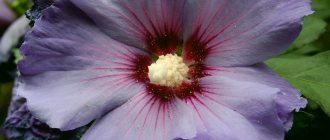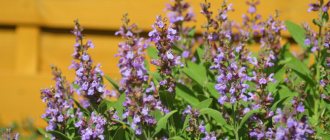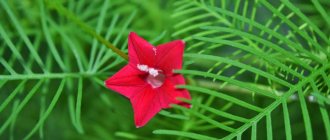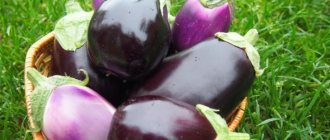Bearded
This is the most diverse and most beautiful group of irises.
Their flowers are very large, the petals can appear in almost the entire palette of colors and in different color combinations. In many varieties, the edges of the petals have contrasting colored frames, beautiful frills or decorative curling. The "beards" may be a different color from the rest of the flower. Bearded irises are hybrid, arose as a result of breeding work. Their height reaches 25-70 cm. The name comes from one characteristic feature. Namely, on the outer petals of the perianth there is a strip of hairs called a beard. The species has a hard, branched stem on which the flower grows, the leaves are narrow and lanceolate.
Bearded iris has few requirements for growing in pots and gardens.
It is important that the soil is permeable and not too wet. It is better to choose a sunny position, especially for young seedlings
You can grow them in partial shade. Propagation is done by dividing the rhizomes in August. Seedlings must be free from diseases. Depending on the variety, the distance between them should be 20 × 25, 30 × 40, 45 × 60 cm.
Bearded varieties can be grown in pots. These garden flowers are great at home.
There are many varieties, they are divided into several groups. In Russian society, bearded species are divided into:
- actually bearded (tall, medium-sized, dwarf);
- arils.
Varieties are also divided according to flower color.
With two-tone flowers
| Variety name | Photo |
| Pinacle | |
| Toll Gate | |
| Helen Collingwood | |
| Broadway Star or Broadway Star | |
| Symphony |
German
This is the type species of Iris. It has a powerful rhizome. A type of perennial plant from which many garden hybrids with large, beautiful flowers come. Native to southern Europe, it is a member of the largest group of tall bearded irises (TB).
The plant forms a creeping rhizome with numerous roots. The leaves of the iris are sword-shaped or saber-shaped, round, hard, with characteristic fan-shaped lobes, 4 cm wide. The flowers are collected in 4-5 inflorescences, from bluish-violet to purple with a yellowish beard, 10-12 cm in diameter. Blooms in May-June, grows up to a height of 60-120 cm. Used in perennial flower beds in combination with peonies, chrysanthemums, on the banks of reservoirs and as cut flowers. Frost resistance is complete.
The soil should be fertile, sandy loam, with a high humus content. The position is sunny, then the plant will produce many bright flowers. Flowers do not tolerate stagnant water; it is worth growing them on elevated beds and small slopes.
Reproduction: by cutting out lateral fragments of rhizomes, each with 1-2 rosettes of leaves, once every 3 years and planting them after flowering, no later than early autumn.
German iris varieties planted in the wrong position are susceptible to numerous fungal and viral diseases. The most common disease is wet rot of rhizomes. Most rhizomes are susceptible to attack by snails. Aphids transmit viral diseases. Sometimes flowers are at risk of rust. Brown blisters on leaves are a sign of a disease called bacterial leaf wilt.
Varieties of German iris are divided by height.
| Name | photo |
| Low – up to 25 cm | |
| Baria | |
| Lilivar (Lilli Var) | |
| Lenna M. | |
| Average height - about 60 cm | |
| Red Orchid | |
| Tall – more than 70 cm | |
| Winter Carnival | |
| Dotted Swiss | |
| Rococo | |
| Cayenne Capers |
The plant, whose requirements are low, can decorate many gardens and home spaces. A big plus is the variety of colors, from white to cream, yellow, orange, red, pink, purple and blue.
There are a huge number of varieties of bearded irises, and breeders present new proposals every year. The most beautiful plants are found among tall and medium-sized varieties.
| Name | Photo |
| Decadence – two-tone | |
| Peach Frost - a charming variety | |
| Ming Dynasty – yellow | |
| Superstition Superstition - almost black iris | |
| Spiced Lemon – brownish-yellow | |
| Change of Pace |
The dwarf iris also boasts a large number of beautiful flowers, for example.
| Name of iris | Photo |
| Yo-yo (Yo-Yo) | |
| Dixie Pixie | |
| Blue Line | |
| Captive Sun | |
| Firestorm | |
| Music | |
| Pele |
Depending on the variety, bearded irises bloom from April to June-July.
Bearded iris
Japanese salmon rhododendron
Its appearance is similar to most other varieties of this plant. The flower got its name due to the presence of a small number of bristles in the upper part of the outer petals.
Bearded irises
This plant is a hybrid. A large number of varieties have been bred on its basis, and breeding work is still actively ongoing. This species has a wide variety of colors, similar to the Dutch iris.
Note! Bushes can have different heights: dwarf varieties grow up to 5 cm, and tall ones - more than 0.7 m. Flowering occurs from mid-June to early July. There are a large number of varieties of different sizes and colors.
Petals are divided into internal and external. The first ones are directed upwards, while the second ones fall beautifully downwards. At the top of the outer petals there is a small bristly beard. The pistil has three lobes and a supraglottic ridge. The stamens are hidden under the pistil and inner petals.
Bearded iris varieties
Tall varieties have a height exceeding 70 cm. The size of the flower can reach 15-20 cm. Medium-growing varieties have a height of 41 to 70 cm. The most famous varieties of the species are:
- table flowers have a branched thin peduncle with 8-centimeter flowers. They are often used to arrange bouquets in vases, which influenced the origin of the name;
- border flowers resemble tall ones in appearance, but have proportionally smaller buds. Can be any color, including burgundy;
- Iris Kopatonic has orange flowers;
- Intermedia has a flower size of 10-12 cm. They are always characterized by abundant flowering, which begins in early June;
- Iris Si Si has purple or yellow flowers;
- Nordica is one of the varieties of white irises. They have white petals with a small orange beard.
Dwarf standard bearded species reach a height of 21-40 cm. The smallest varieties are miniature bearded dwarfs. Their height ranges from 5 to 20 cm.
Landing
This plant prefers neutral or slightly alkaline soil. It must be moisture permeable. Clayey and acidic soil is not suitable for bearded iris. If they need to be planted on heavy soil, it is recommended to add sand to it.
Note! Iris Delicia really needs plenty of sunlight. If you plant it in the shade, it will not grow in such conditions.
The best time to propagate and plant these plants is after flowering has ended. During this period, active root growth occurs. They can be seen on the soil surface in the form of light green small tubercles. As they grow, they become fragile and break off easily. Until this happens, you can reproduce by dividing the roots. This can also be done later during the fall when the root system becomes fibrous and tough.
When planting, make a hole into which the root of the plant should fit freely. A small mound is placed in its center. The plant is placed on it and the root is carefully spread around. Then pour in the required amount of soil.
When planting, you need to make sure that the roots are located under the ground and do not stick out. This is important to ensure that they are warmed by the sun's rays.
Bearded Iris Care
Planting and caring for bearded iris in open ground is carried out as follows. This plant generally does not need watering. The need for it may arise only during severe drought. However, the bushes need to be periodically weeded and pruned.
Important! It must be remembered that loosening the soil near this plant must be done with great care. This is due to the fact that the root system is located near the soil surface and can easily be damaged.
Gradually, over the years, the outer part of the plant grows, while the inner part gradually ages and dies. Over 3-4 years, a cluster of dead rhizomes forms in the center. To prevent this, the plant is divided and replanted.
In August, it is necessary to pick off the leaves that have dried out.
Dwarf and medium-sized flowers do not need shelter for the winter. However, it is recommended to cover tall garden varieties with spruce branches, sawdust, peat or similar material.
It is not recommended to overfeed the plant with nitrogen fertilizers. It is customary to apply fertilizing after flowering has ended. The plant will benefit from the addition of ash.
Shelter for the winter
Fertilizers are also applied at the beginning of the growth period in the spring (20-30 g of ammonium sulfate and potassium chloride) and when buds begin to form (the same composition as in the previous option).
Growing irises
Swamp calamus
Growing conditions. All irises are light-loving, but their different relationship to water should be taken into account - yellow, Kaempfer and bristly irises are grown on wet, constantly moist soils. With normal moisture – Siberian iris; on light, well-drained soils, other types and varieties of bearded irises.
Reproduction. By dividing the rhizomes after the end of flowering (late July-August) every 4-5 years. A delenka is a one-two-year section of rhizome with a trimmed bunch of leaves and a renewal bud. After digging, the rhizomes of the mother bush are heated in the sun for 5-6 days. The plot is planted superficially, sprinkled with a thin layer of soil. For the winter, fresh plantings are mulched with wood chips or covered with spruce branches.
As you can see in the photo above, moisture-loving irises are planted near ponds. Dry-loving, low - on rockeries and in the foreground of mixborders. Bearded iris in combination with peonies, heuchera, low varieties of goldenrod, coreopsis, and lavender creates a magnificent variety of colors in flower beds and mixborders.
After flowering, the leaves are cut in half and the flower stalks are broken out. Iris is also used as a cut flower.
Growing
Iris calamus spreads naturally from seeds. In the same way, wild forms of plants are propagated in flower beds. When cultivating a varietal flower, cultivation is done by dividing the rhizome. For transplantation, those parts that contain the kidneys are taken.
Caring for iris is not difficult. Basic requirements for its growth:
- illumination The plant loves the sun's rays. But it also tolerates slight partial shade without pain;
- rich soil. Prefers acidic soil rich in organic matter. Lowlands where liquid accumulates after precipitation are ideal;
- hydration. If the flower is not planted near a pond, it should be watered regularly to prevent the soil from drying out.
This unpretentiousness makes the iris calamus in demand when decorating flower arrangements by landscape designers. The culture spreads quickly using creeping rhizomes, so it does not require annual replanting.
Yellow iris has been undeservedly deprived of the attention of gardeners. After studying its properties, wild varieties began to spread and new cultivated species were developed.
Economic importance and application
Iris ensiform
Freshly dug rhizomes have a herbaceous smell, and only when dried slowly does a pleasant violet aroma appear, which is why it is called “orris root” (used in confectionery production, as well as as an aromatic raw material for, and other drinks).
Iris essential oil is widely used in perfumery.
Iris has an expectorant effect and improves the taste of medicines. Alcohol-water rhizomes at a dilution of 1:300 inhibits development. Rhizomes are part of the breast collection, used internally in the form, externally - in the form; are included in tooth powders.
In folk medicine, yellow iris was used for , , , as well as for the treatment of infected , , and for removal. The juice of the roots was previously used externally for toothache, for tumors, and internally for and. The root was previously used for diarrhea.
Attention: there are suspicions that fresh rhizomes and flowers are poisonous.
The false calamus is decorative and has long been widely used in plantings bordering water bodies; under cultural conditions it can grow in places with very moderate moisture.
The plants are suitable for leathers that give a yellow color. Rhizomes and flowers infused with it dye the wool yellow.
The plant is interesting because, like the plant, it significantly reduces water pollution with organic substances.
Yellow iris is good.
The seeds make up .
Iris false calamus - beneficial properties, description
Iris includes 250 species that grow throughout Asia, Europe, North America and some areas of Africa.
This perennial is a unique herbaceous plant with powerful corm-like rhizomes. They have two main types of shoots - generative and vegetative. Sword-shaped flat leaves with a waxy coating are collected at the base of beautiful peduncles in special fan-shaped bunches. Many species have few or no stem leaves. Single flowers are located in few-flowered inflorescences. They are distinguished by their fragrant aroma and elegant shape. The rich range of different shades includes a wide palette from dazzling white to dark purple. The large flowers consist of six petal-like lobes of a typical perianth. The three outer lobes are always slightly lowered. The flower's ovary has a three-lobed shape, and the pistil is somewhat dissected into 3 lobes.
Irises usually bloom from May to mid-July. The life span of each inflorescence is approximately three days. A flower bud is formed on the rhizome in summer. The fruit of the plant is represented by a three-lobed capsule. There are up to 16 seeds in one gram. Irises prefer to settle in open spaces, choosing the banks of reservoirs, steppe zones and deserts.
Useful properties of iris
In modern medical practice, several varieties of irises are allowed for use, including decorative varieties of Florentine and Germanic. The rhizomes are considered the main medicinal raw material of the plant, since their main active ingredient is a unique essential oil. The active component of this oil is iron ketone. Rhizomes are collected after planting in the third year. They should be washed in water, cleaned of lateral roots and aerial parts, dried thoroughly and stored in closed jars.
The rhizomes contain a large amount of essential vitamin C, starch, special sugars and other useful substances. In aromatherapy, the exceptional orris root is highly valued as a mild sedative. The plant is often used as an excellent expectorant and mild laxative. A healing decoction of orris roots helps to resolve dense tumors, eliminate severe headaches, and also cures gastrointestinal colic, bronchitis, sore throat and even pneumonia.
In modern cosmetology, a decoction is indicated for the effective elimination of freckles, pimples, wrinkles, and dandruff. This product is used for severe hair loss. This is an excellent hair stimulant that simultaneously increases hair thickness and shine.
Large iris leaves contain a significant amount of ascorbic acid. In India, rhizomes have long been used as an astringent and diuretic. And in some European countries, crushed leaves are still consumed due to their diaphoretic properties.
It has been proven that in addition to essential oil, iris contains isoflavones, flavonoids, iridine glycoside, carotenoids, fatty oil, various organic acids and tannins. It has immunomodulatory, anti-inflammatory, antitumor, antibacterial, antimycotic, detoxifying, antioxidant, anthelmintic, hemostatic, astringent, antipyretic, diuretic, restorative, analgesic, tonic and obstetric effects.
Application of iris
In the form of miraculous infusions, the plant is used for toothache and dropsy. For scurvy, various iris rinses are prescribed. Rhizomes are part of the popular breast tea. Modern homeopathic remedies based on the presented plant are prescribed for the effective treatment of the salivary glands and inflammation of the pancreas.
To prepare the infusion, you will need a glass of boiling water for 15 grams of raw materials. This remedy can be taken orally up to 6 times a day, 1 tbsp. l. Dried orris roots are considered an excellent expectorant and blood purifier. In addition, it has a powerful diuretic effect. It is prescribed for papillomatosis of the bladder and serious anacid gastritis.
To prepare a decoction of iris, you need to take 1 tsp. powder of crushed rhizomes and pour 300 ml of boiling water over them. Boil the mixture over low heat, always covered, for at least 5 minutes. Then the product should be infused in a warm place for about two hours. After straining the resulting decoction, it is recommended to gargle and rinse the mouth for sore throats and stomatitis. To get rid of long-term non-healing wounds and trophic ulcers, you can wipe them with this wonderful remedy.
For coughs, pain in the gastrointestinal tract, colds, as well as for bladder cancer and polyps, it is recommended to take half a glass of the decoction orally warm. For neurodermatitis and diaper rash, it is recommended to sprinkle the affected areas of the skin with powder from iris rhizomes.
A healing tincture of iris is prepared within two weeks from a ratio of 1 part rhizomes, which are finely crushed, and 10 parts regular vodka. In case of circulatory problems, severe pain and constant cramps in the stomach, you can take 20 or 30 drops per day at least three times a day. The tincture should be diluted in a small amount of water. This remedy is also indicated for the treatment of chronic pulmonary diseases.
An alcohol-water extract from medicinal iris rhizomes actively inhibits the development of tuberculosis bacillus. The essential oil of the plant is used in perfumery and aromatherapy. The fantastic aroma of the oil gives a feeling of comfort and harmony, it improves mood and helps with nervous disorders. Various creams based on the presented iris oil can boast a powerful regenerating effect, while at the same time they make the skin soft and velvety.
Article on the topic: Hawthorn monopistillate - beneficial properties, description
Iris bulbs
The bulbous iris has an interesting development cycle, similar to the development period of tulips. In temperate climates, bulbs can be planted in the fall. They take root fairly quickly in low temperatures and sprout in early spring. When flowering occurs, a daughter bulb is formed. As a rule, this always happens in the summer. When dug up, each bulb often has 3 leaf embryos. During a snowy, frosty winter, it is not necessary to cover iris plantings. In the absence of snow, it is advisable to insulate them with a layer of dry leaves.
Iris drops
Miracle iris eye drops are a special preparation. The transparent liquid is yellow in color because it contains a special aqueous polyvinylpyrrolidone and a solution of gentamicin sulfate. These incomparable drops have a fairly pronounced bactericidal effect. They are destructive to many gram-negative and gram-positive bacteria. These include the dangerous Pseudomonas aeruginosa.
This product has regenerating and prolonging properties. When installed into a special conjunctival cavity, the drops are absorbed throughout the conjunctival mucosa. They easily penetrate into the intraocular media through the cornea. This ensures the required concentration of the drug inside each eye. Iris drops provide excellent antibacterial effect for serious lesions of the cornea and conjunctiva.
The main indications for the use of the drug are not only treatment, but also prevention of keratitis, conjunctivitis, blepharitis and iridocyclitis in all dogs and cats.
Essential oils of iris
The healing essential oil of iris is extracted from the dried roots. The plant undergoes a special extraction method. The essential oil has a yellowish-brown color and a sweetish aroma. It contains more than 140 unique components. These include geraniol, stearopten, linalool, eleopten, betulenol, betulen, methyl salicylate, iron, ketones, benzaldehyde, as well as acids such as salicylic, lauric, oleic, stearic, palmitic and others. Iris essential oil is used only externally to relieve pain, relaxation and relaxation.
Iris seeds
The seeds of the plant germinate easily when sown in the ground. The best germination, as a rule, is observed in fresh seeds. They are often used to prepare a delicious drink that can replace regular black coffee. In addition, the seeds are an excellent way to uniquely flavor various alcoholic beverages.
Growing iris
When choosing a landing strip, pay attention to protection from wind and stagnant water. Most of the day should be sunny. The soil should be fertile with humus or compost, and you can also add a little bone meal. The rhizome cut should be white and clean, without any visible damage or stains. Irises are planted at a distance of 30 cm from each other. The top layer should always be loose and breathable.
After 2-3 years, lush bushes of sword-shaped green leaves appear from the planted cuttings. Then strong flower stalks are formed, which will have up to 7 graceful buds. Watering before flowering begins is a must. Wilted flowers should be removed immediately. After flowering, it is recommended to cut off the flower stalks.
Varieties and types of irises
Irises vary in the richness of their tones and the duration of flowering. This plant boasts a wide variety of varieties and species
Bearded iris. This variety is considered the most popular of garden irises. The bases of the outer petals are decorated with special stripes of hairs, which stand out against the general background with a contrasting color. Bearded light-loving irises come in low, medium and large heights. Their height can vary from up to 70 cm.
Siberian iris. Its distribution area is vast territories, ranging from the north of Italy to the purest Lake Baikal. Populations of the plant are also found in the Komi Republic, the Caucasus and Northern Turkey. The rhizome of the Siberian iris has brown remains of leaf sheaths at the top. The branched stem has several stem-enclosing leaves. Beautiful flowers are on unequal stalks. There are light gray seeds in a small box.
Dutch iris. Such a perennial has a special underground organ where reserves of substances are stored instead of rhizomes. Several daughter bulbs are formed annually. The leafy, durable peduncle reaches a height of up to 80 cm. The stem has narrow-grooved, dense leaves. The color of the flower can be either one-color or two-color. This variety is considered heat-loving and requires shelter from cold and winds in winter.
Iris dwarf. This species grows well in feather grass and dry grass steppes. He is also happy to settle in rocky limestone slopes, salt licks and sands. The height of this perennial plant is no more than 15 cm. All its leaves are basal and have a bluish tint. The length of the peduncle reaches 3 cm. The dwarf iris blooms in early May. It tolerates dryness well.
Swamp iris. It can often reach one meter in height. Beautiful golden yellow flowers are decorated with brown streaks. This unique variety blooms in May and June. This plant is considered heat-loving and winter-hardy; it prefers direct sunlight. In the wild, marsh iris chooses floodplains and various banks of reservoirs. It can often be found anywhere in Europe, in Siberia, the Far East, China and Japan.
Iris ensiform. This plant is a late-flowering species. The height of the narrow leaves does not exceed 40cm. Flat flowers have short inner and rather wide outer petals. The average height of peduncles is no more than 70 cm. Under natural conditions, it always blooms from mid-July to mid-August. The xiphoid iris with a special thickened rhizome is found in Korea, China and Japan.
Article on the topic: Japanese butterbur - useful properties, description
Iris contraindications
The main contraindication to the use of the plant is only individual intolerance to the components.
Education: Diploma in General Medicine and Therapy received from the University named after N. I. Pirogov (2005 and 2006). Advanced training at the Department of Herbal Medicine at the Moscow People's Friendship University (2008).
Swamp iris.
Author VLD Flowers Created 13
Neomarika walking iris how to grow
Dec 2013
Swamp iris (Iris pseudacorus), false calamus iris, yellow iris, water iris, calamus iris is a perennial herbaceous plant of the genus Iris, family Iridaceae.
Swamp iris reaches a height of up to 75-160 cm, and sometimes up to 2 meters. The stem of the plant is dense, branching in the upper part. Swamp iris has green leaves, sword-shaped, 10-30 mm wide, with a clearly visible vein running through the middle leaf.
The flowers are located on a branched stem in bunches of 12-15 pieces, according to one source. They have a yellow color and an orange-brown pattern on the lower petals. The rhizome of the marsh iris is powerful, branched, creeping, thick, up to 2 cm in diameter.
Swamp iris. This flower grew on the bank of a small river in the Tver region.
In its natural environment, marsh iris (Iris pseudacorus), in fact, prefers to grow not in swamps, but along river banks. This is due, among other things, to the way this plant reproduces. Swamp iris seeds spread through water. They do not drown in water, and once in it, they float with the flow, thus finding new habitats. Plants that reproduce in this way are called hydrochores.
Despite the fact that the marsh iris is a coastal plant, it can withstand prolonged immersion in water, for example, when the banks of a reservoir are flooded. The marsh iris blooms in June - August. The fruits ripen in August. Swamp iris (Iris pseudacorus) is widespread in the European part of Russia, grows in Western Siberia, in the foothills of the Caucasus, and the southern regions of the Far East. Swamp iris is widely used for decorative purposes, most often for decorating reservoirs. Thanks to the unpretentiousness of the plant, Due to its shade tolerance, even wild forms of marsh iris quickly and successfully take root in gardeners’ plots. It is only necessary to sow the seeds of a wild plant deeper, 1.5 - 2 cm, otherwise they may be washed to the surface during rain or after watering. Swamp iris can grow in one place for many years without requiring replanting or any special care.
Swamp iris is a charming creation of nature.
Swamp iris is an unpretentious plant that is very well suited for decorating artificial reservoirs.
photo Vlad IONOV.
You do not have sufficient rights to add comments. You may need to register on the site.
Propagation by seeds
As for generative propagation using seeds, here things are even simpler. Yellow marsh irises tend to self-sow; planting material retains its viability for a long time. Irises are sown immediately in open ground, to a depth of 1.5-2 cm, it is important that it is not heavy and well moistened. This should be done in the fall before winter. The first shoots appear as soon as the snow layer melts. Irises grown from seeds bloom only after 3-4 years.
To plant swamp iris in a pond, use a container with nutrient soil. This is necessary in order to preserve the plant during the winter. If you do not remove it from a pond or other body of water, the iris will freeze into the ice and die. The plant is planted in such conditions in August to a depth of no more than 20-40 cm.
If planting is carried out in open ground, then the rhizome divisions are planted to a depth of no more than 10 cm. The ideal place is a coastline with organic-rich soil in partial shade or well-lit by the sun. Soil mixtures with an acidic reaction are suitable.
Moisture-loving plants are suitable as companions for marsh irises. If you are planting a crop in a flower bed, then choose plants that will bloom at the same time. For example, tulips, forget-me-nots and lilies are perfect for creating flower arrangements. Also, various low shrubs and trees look ideal next to plantings of yellow irises. The culture can be used for “green” zoning of the garden.
Classification of types and varieties
There are many groupings of these plants according to various characteristics, including height, color and size, and inflorescence structure.
In the international classification, irises are divided into 3 groups:
- rhizomatous:
- bearded;
- beardless;
- bulbous:
- xifums (Xiphium);
- juno (Juno);
- Iridodictyum;
- morea (Gynandiris).
- Dutch.
However, the Russian iris society does not classify bulbous species as irises.
Rhizomatous irises
| Bearded | Beardless | |
| Name | Flower diameter, cm |
|
| MDB - miniature dwarf | 6-10 | |
| SDB – standard dwarf | 8-10 | |
| IB – intermediate intermedia | 7-12 | |
| BB – curb | 6-12 | |
| MTB – miniature tall | 5-8 | |
| TB – tall bearded | 12-20 |
Below are the main types of irises and their popular varieties with photographs.
Features of reproduction
Like other plants, swamp iris reproduces in a variety of ways. Each of them is good in its own way:
- By dividing the rhizome. To do this, you need to dig up a swamp iris bush with a good lump of soil and clean the root. Using a sharp knife, cut into slices. Each of them should have 2-3 lateral buds and one central shoot. Sprinkle cut areas with charcoal or ash to prevent disease. Cut off the leaves a little before planting. To root, plant the cuttings first in containers and then in a permanent place.
- Seed propagation. The material has a dense peel, so it requires stratification for germination. Swamp iris seeds are sown in the ground late in the fall and a film is placed on top. In spring they are planted.
Comment! Swamp iris grown from seeds will bloom only after three years, so flower growers most often prefer the vegetative method.
Reticulate
Iris reticulata is the main representative of the bulbous iris species. It usually reaches a small size (about 15-20 cm), and is one of the first to bloom in spring (III-IV). After flowering in early summer (VII), it dries out and the plant can begin to propagate. The flowers usually have varying shades of purple, with contrasting yellow spots on the petals, although some are also quite yellow. Blue irises are common.
The reticulated iris should grow in sunny places, protected from the wind. The best soil for it is permeable and warm. The species is ideal for rock gardens, edgings, and creating an early spring garden in a container. The soil should warm up quickly. The bulbs are planted at a depth of 5 to 6 cm.
Most popular varieties
| Name | Photos |
| Ash Gem | |
| Cantab – light blue | |
| Harmony – deep blue sky colors | |
| Ida – blue with dark blue and yellow spots | |
| Joyce – sky blue | |
| Katharine Hodgkin – pale blue and yellow | |
| Natascha – light blue with white and golden yellow spots | |
| Pauline – purple with white spots | |
| Ash Gem or Violet Gem – purple and plum purple |
Diseases and pests
| Bacteriosis Ways to fight:
| |
| Fusarium Ways to fight:
| |
| Bronze beetle Ways to fight:
|
Taxonomy
Type of iris false calamus
included in the genus (
Iris
) (
Iridaceae
) (
Asparagales
).
| 24 more families (according to) | about 400 more species | |
| order | genus Iris | |
| Department | family | species Iris false calamus |
| 44 more orders of flowering plants (according to) | 70 more births (according to) |
Synonyms
According to 2013 data, the types include:
- Acorus adulterinus,
- Iris acoriformis
- Iris acoroides
- Iris bastardii Boreau
- Iris curtopetala
- Iris curtopetala F.Delaroche
- Iris flava Tornab.
- Iris lutea
- Iris pallidior
- Iris paludosa
- Iris palustris,
- Iris palustris, nom. illeg.
- Iris sativa
- Limnirion pseudacorus ()
- Limniris pseudacorus (L.) Fuss
- Moraea candolleana
- Pseudo-iris palustris
- Vieusseuxia iridioides F. Delaroche, nom. inval.
- Xiphion acoroides (Spach)
- Xiphion pseudacorus (L.)
- Xyridion acoroideum (Spach)
- Xyridion pseudacorus (L.) Klatt
| From left to right. Flower. Ripening boxes. Seeds |
Planting a plant
Before planting, the correct location for the marsh iris is selected, as well as the seed material. Following the recommendations of experienced gardeners will prevent mistakes and allow you to get a beautiful and healthy plant.
It is recommended to do planting work in August or September, then the plant will take root faster and will delight you with abundant flowering in the spring.
Selection of planting material
It is recommended to purchase planting material at specialized points where sellers provide a certificate of conformity of the variety. At the same time, make sure that there are no signs of diseases or damage by pests on the plant. The further development and flowering of irises depends on the quality of planting material.
Soil preparation
All work begins with soil preparation. It must be remembered that for the successful cultivation of swamp iris, shallow and sufficiently moist areas that are well illuminated by the sun throughout the day are suitable. Also, the area must be protected from strong winds and drafts.
Swamp iris does not have any special requirements for soil quality. It should have an acidity of around 7 pH, a fertile composition, and a heavy, clayey structure.
Planting scheme
There is no difficulty in the planting process; it is carried out according to the following instructions:
- To prevent uncontrolled growth of the crop, containers are prepared; their volume must be at least 5 liters.
- Take ordinary garden soil and add 2 buckets of humus to it.
- Pour a little water to achieve a porridge-like consistency of the soil and place it in prepared containers.
- The long roots of the plant are shortened and the leaves are cut off by a third. Planting is carried out in containers to a depth of 10 cm.
- Make sure that the root is located at the edge of the container, and not in the center, since irises tend to grow sideways. The thickening on the rhizome should remain above the surface of the ground.
- Containers with planted irises are placed at the bottom of the selected reservoir; the immersion depth varies from 20 to 40 cm.
Plants are planted in the same containers not only at the bottom of the pond, but also in the coastal zone and in the flowerbeds of the site. Some gardeners replace the soil in containers with crushed stone or stones.
Japanese
Slightly less popular than the bearded species, these species are rarely found in home gardens, but deserve interest. Despite their exotic origin, growing Japanese irises is not difficult. They prefer sunny positions (although they tolerate some shade). The soil should be moderately moist with a neutral reaction. Plants look great on the banks of ponds. The flower is planted from March to May.
Japanese irises are beardless plants. They usually reach a height of 1 meter and bloom quite late (July-August). The inflorescence of Japanese irises has a slightly different shape than other species, it is flattened and has smaller central petals.
White or burgundy flowers usually appear on the shoots. The flower has high frost resistance - it can winter in open ground, but should not stand in water.
There are many varieties in this group that differ from each other mainly in flower color.
| Name | Photo |
| Edmonton | |
| Marmouroa | |
| Azure | |
| White Lady | |
| Oriental Eyes |
Why doesn't the yellow swamp iris bloom?
Some gardeners, having received such a plant in their garden, are often surprised: why does the marsh iris not bloom? The answer to this question is very simple. This ailment can occur for several reasons, which you can try to eliminate yourself:
- yellow swamp iris does not bloom due to lack of moisture - try to increase the amount of watering, if after 2-3 weeks the plant has not formed buds, then the problem is different;
- insufficient lighting - when growing in open ground, transplantation to a new location will be required;
- the impact of weeds, the neglect of a bed with marsh irises leads to the fact that unwanted guests on it begin to take away nutrients, thereby the crop simply stops blooming;
- This is a young planting grown from seeds - remember that during generative propagation, irises bloom for 3-4 years.
Also, marsh plants do not bloom when they grow strongly due to age - try renewing the plantings by dividing.
Siberian
It is rare to find Siberian iris in the garden; it is more often found in natural meadows. The Siberian species prefers sunny positions. It forms large bales and is not particularly picky about the soil. Siberian iris can grow up to 70 cm in height. The leaves stand out in appearance; they are quite long, thin, and acquire a slightly blue tint.
The plant produces small white or purple flowers, developing in groups of 2-3 at the end of a long, thin shoot. These are not the only colors, there are also blue irises. Flowering period: May – July.
The Siberian species is frost-resistant, so it grows well in our climate. However, this requires fertile soil with a slightly acidic reaction. Its cultivation is not difficult, there are no big requirements. Since the Siberian species loves moisture, regular watering is most important, especially during drought. Fertilizer is carried out only before planting if the soil in the garden is not fertile enough. The plant can overwinter in the ground without freezing. Despite this, it is worth covering it with leaves or straw.
The most popular varieties of violet-blue flowers. However, in addition to this, other colors are also available. The White Siberian Iris is distinguished by its beautiful white flowers. White Siberian irises are believed to be a variety originating from Germany, although this is not official. Grows well in sunny places, on fertile soil. The variety is considered the most noble.
| Name of iris | Photo |
| Snow Queen | |
| Barbata Media is a plant 40 cm high. | |
| Barbata Elatior - flowers 70 cm high. | |
| Siberian varieties are blue-blue in color - flowers bloom from July to August. Flower petals are smaller, but with more inflorescences. One of the most interesting varieties is Perrys Blue. This variety blooms very profusely with blue spring flowers (blooming: May-June). The plant is completely frost-resistant. It can be planted in flower beds. Looks great next to a pond. |
Cultivars are usually intensely colored, may have white or yellow patterns, and larger inflorescences.
Some varieties of the Siberian species - photos and descriptions
| Variety name | Siberian Iris – photo |
| Concord Crush - flower petals turn blue, turning into a purple hue. The variety is called multi-petalled. Flowering begins in May. | |
| Dear Delight is a flower with blue petals with white spots and a visible vein structure. | |
| Hubbard - varieties characterized by an intense purple-pink color. The flowers are very large, with white coatings along the edges of the petals. | |
| Jamaican Velvet is a variety of intense purple color. The petals are distinguished by lighter spots, which are characteristic of this flower. | |
| Pink Parfait “Pink Parfait” is a multi-petaled variety, the flowers of which reach a diameter of 16 cm. The color of the flowers is pink. | |
| Miss Aplle is a hardy flowering plant that is distinguished by its relatively young age compared to other varieties. The color of the pink petals turns into lavender and purple. | |
| Rosy Bows is a variety with double petals. The pink color turns into light purple, blue. | |
| Jeweled Crown | |
| Fortel | |
| Contrast in Styles |
Iris false calamus - beneficial properties, description
Irises are perennial herbaceous rhizomatous plants. You can often find evergreens. Bulbous species of irises also grow in nature, but in the domestic botanical classification they are classified into separate genera: iridodictium, xyphium, and also juno. If we are talking about rhizomatous irises, then their shoots can be of two types: either vegetative or generative. Vegetative parts are those located above or below the ground, acting as a place for the development of adventitious roots or tufts of leaves. As for the second type - generative, they include flower stalks that are present on the grass for only one year, after which they die off on their own or through the intervention of a person who removes them.
Article on the topic: Mahorka - beneficial properties, description
The leaves come in various shapes - xiphoid, flat, two-row, linear. Often they are concentrated in a fan-shaped bunch located at the base of the peduncle. The absence or presence in small quantities of stem leaves is characteristic of iris. Flowers in most cases are placed “single” or concentrated in few-flowered inflorescences; the palette of shades is varied: from white to dark shades, sometimes even almost black ones are found. Large flowers are made up of a perianth, which is divided into 6 parts, often called petals. The three outer lobes are directed downward in the vast majority of cases. Their shape, shade and dimensions are often not the same as those of the other 3 upward-facing lobes. Flowering time is May-July. After flowering, in August, fruits are formed - 3-cell boxes.
Due to their long-lasting and bright flowering, these plants are loved to be used in flower beds, near ponds, and in aesthetic rock gardens. Irises will look most beautiful together with lupins, poppies, and also peonies. Based on the geography of the plant’s growth, it is worth saying that irises are most common in the Mediterranean countries and Central Asia. The homeland is considered to be Europe, North America, Asia. Irises love fertile soils. Many types of irises do not tolerate high humidity and darkness. Nitrogen supplied to irises in abundant quantities provokes the occurrence of diseases. This plant will demonstrate the best growth on loamy soils with a neutral or, alternatively, slightly acidic reaction.
Dutch
Siberian iris is not the last proposal for the garden
It is also worth paying attention to other species, one of which is the Dutch bulbous iris (Xiphium hollandicum). The plant can reach 60 cm in height and blooms in June
This is a bulbous hybrid that produces tall shoots on which single flowers appear. Some petals have yellow spots. The flowers are yellow, white, purple and blue. Dutch irises are used for cut flowers.
They are among the easiest irises to grow, although they can freeze in winter. The Dutch iris needs a sunny position and protection from the wind. The optimal soil is fertile, rich in humus, and permeable. Bulbs are planted from April to May to a depth of 10-12 cm. The soil must warm up.
Reproduction is carried out by separating the baby bulbs. This is done during the plant's rest period.
Varieties of Dutch iris
| Name | Photos |
| Barboletta - variety produces large blue flowers, flowering period - May-June | |
| Pink Parafit - lavender-colored petals, arranged slightly differently, reminiscent of terry begonia. Flowers reach 16 cm. |
Swamp iris care
The species of marsh iris is very unpretentious to care for; it is more important for it to choose an initially suitable place and then it will delight with flowering for several years. To plant crops, choose places with good lighting. The only thing that can harm the iris is cold and strong winds. You can protect the plant from them by planting it near vertical buildings. When growing in flower beds, pay attention to the fact that other perennials can limit the root system from nutrients. Never plant irises with ground cover plants - they can “strangle” it. For the same reason, watch out for the appearance of weeds near the plantings. It is recommended to loosen the soil shallowly so as not to damage the root system.
Watering is increased in the hot season if marsh iris grows in open ground.
When planting, you can dig up a place in the garden with clay to increase its moisture capacity. But clay soils are often heavy, which is not always suitable for growing irises, so you should not get carried away with this material. Transplantation is carried out only if necessary. It is recommended to renew plants by dividing the rhizome and replanting it to new places no more often than once every 5-7 years.
Description Iris marsh or calamus
Photo: Swamp iris or calamus
Swamp iris grows in the wild along the banks of rivers and other bodies of water. Seeds are dispersed by water. The species' range is currently enormous. It grows throughout Europe, excluding the far north. Found in the Mediterranean, Iran, Turkey, Syria. Africa, western Siberia, the south of the Far East, Japan and China. In the 20th century, marsh iris spread to North and South America. You can easily verify the extraordinary vitality of this species by planting it in the beds. Its numerous seeds produce massive shoots in the spring. Seedlings with powerful roots quickly grow into the soil and two-month-old plants are very difficult to pull out of the ground.
Swamp iris can be identified by its rhizomes. If you cut them, then the initially light cut quickly turns brown. Previously, tanners used its rhizomes to dye leather. A characteristic feature of the species is the protruding central vein of the leaf. The slightly branched stem of marsh iris, 80 cm high, bears up to 15 flowers, the upper petals of which are underdeveloped. The lower petals are golden yellow, with a large orange spot. Occasionally there are marsh irises with a white flower. This form is now widely used in floriculture. The color of the foliage ranges from matte green to rich bluish (due to a waxy coating). The variegated form is very decorative, popular in many collections of botanical gardens and amateur flower growers. In some parks in St. Petersburg there is a garden form of marsh iris called Bastard iris. The petals of its flowers occupy a horizontal position, rather than down, and lack an orange spot. The flowers of the Bastard iris, pale fawn with a pink tint, are large, up to 14 cm in diameter. The banks of reservoirs decorated with this plant are exceptionally elegant during the flowering period.
Growing marsh iris is not difficult. Seeds should be sown deeper (2 cm) so that after rain or watering they do not float to the surface. Cultural forms reproduce by parts of rhizomes. When the soil dries out, especially during the flowering period, the decorative value of the iris decreases. For decorative purposes, due to its super-powerful development, marsh iris is best used in parks. The plant can remain in one place for many years without transplantation or special care. It is also quite shade tolerant. Swamp iris can withstand prolonged flooding, so it can be planted to a depth of 30 cm in a pond.
Planting iris in open ground and subsequent care for it
To plant swamp iris, you need a place with good lighting and loose soil, as well as knowledge of some of the nuances of reproduction, because without this it is simply impossible to get new plants on your site. Flower growers, taking advantage of the fact that the crop actively grows along the banks of swamps, lakes and rivers in the wild, plant perennials not only in the ground, but also directly in the reservoir. Planting and caring for swamp iris can be organized in various ways.
First, let's look at several options for propagating the plant, and then together we will select a suitable place for planting.
Growing irises is very simple. For this purpose, vegetative or generative (seed) propagation of the plant is used. The first option is possible in the fall or spring, after or before active flowering - dig up the plant and divide its rhizome and transplant the divisions to new places. It is important to use parts of the root system with leaves or buds to restore growth.
For divisions with leaf blades, the upper part of the green tops is cut off, leaving only a small shoot no more than 20 cm long. This is necessary so that it is easier for the new bush to form and the old leaf shoots do not take away their strength. It is preferable to carry out this procedure in late autumn before wintering - this way the perennial will bloom next year and will be easier to tolerate severe frosts. Such planting of marsh iris in open ground will ensure ease of plant care throughout the life of the planting.
Varieties with a rich history
The most numerous are high varieties bred in different periods of the last century. In addition, several of the most ancient varieties, bred in the 19th century, stand out.
| Name | Photos |
| "Flavescens" (De Candolle, 1813) | |
| "Honorabile" (Lémon, 1840) | |
| "M-me Chereau" (Lémon, 1844) | |
| "Mrs Horace Darwin" (Foster, 1888) |
The group of low (miniature, dwarf) and early flowering represents about 20 varieties, including:
| Name | Photo |
| Buddha Song | |
| Derring-Do | |
| Forest Light | |
| Lilli-White | |
| Scribe |
It is difficult to name the most beautiful varieties of irises. However, it is worth mentioning some of them, which have received many awards, including the highest award - the British Dykes Medal from the British Iris Society.
| Name | Photo |
| Amethyst Flame with amethyst pink flowers | |
| Eleanor's Pride with blue | |
| Stepping Out background with white and purple | |
| Sable Night with black veins |
Characteristics of crop types
Marsh wild rosemary: what it looks like, properties and uses
Yellow swamp iris, calamus iris and false calamus iris are not different species of the same crop, as some inexperienced gardeners believe. This is the name of the same flower, their description is absolutely the same. However, it is the basis for many bred varieties and hybrids of decorative irises, the growth of popularity, active selection and cultivation of which began only in the 2nd half of the 20th century (before that, the type of bearded irises was more used for hybridization work). The German breeder E. Berlin was most involved in breeding new varieties of marsh iris, who developed a whole line of varieties of marsh iris. Also bred and successfully grown:
- Umkirch - the flowers are pale yellow with hints of pink;
- Holden Clow - a thin purple mesh runs along the yellow petals, the top two are completely purple;
- Sun Cascade and Pagoda Dyble - have light double inflorescences;
- Kurlen is an original natural hybrid of marsh irises from the Kursk and Leningrad regions, has flowers that are one and a half to two times larger than wild ones;
- Iris Mtskheta is an elegant variety, bred in Georgia, has distinctive features (narrowness of the leaves with virtually no waxy coating, the shade of yellow on the flowers is very pale), which make it possible to identify it as a separate species of marsh iris; wintering for such flowers is very problematic;
- Roy Davidson - bred by the American B. Hager, distinguished by wide, glossy leaves, on which thrips - a constant pest of iris plants - does not land, as well as intolerance to cold weather (requires shelter);
- Bastarda - has a horizontal arrangement of petals, in contrast to those lowered down, like the original water irises, and also lacks the characteristic orange spot; the flowers are larger than average, colored a stunning pale pink with a fawn tint;
- Variegata is one of the best varieties of swamp iris developed, with green-yellow striped foliage.
Additional Information . The latter variety has an award from the Royal Horticultural Society of England.
Swamp iris Roy Davidson
Swamp iris - description, planting and care, photo of yellow iris
These magnificently beautiful flowers, similar to orchids (but not at all) can be found in all corners of the Northern Hemisphere - from 30⁰ northern latitude and up to the 70th parallel, where the polar zone with its permafrost soil begins.
In the wild, you can often find a fellow iris (or iris, or cockerel) - with a bright blue or blue-violet color.
In which the “beard” of the lower petal is colored with yellow thin longitudinal stripes running deep into the throat, like a guide path for pollinating bumblebees. But the hero of our material is no less common.
True, it has a difference from other varieties and subspecies - it lives “knee-deep” in water, while other irises try to climb higher, onto the slopes of hills, hills, and sometimes just hillocks.
Description and characteristics
It happens that a gardener has a small pond on his property, or a dam from a stream, which, after passing the artificial dam, runs on. Or simply a drainage ditch that is full-flowing at any time of the year is laid along the site. Then, along with the usual sedge or reeds in such cases, you can often see a bright yellow spot of blooming marsh iris.
But if even a single specimen of the iris of this flower appears, in a few years the owner of the site will experience an increase in his family to 20-30.
And it is not surprising: along with the seed method of propagation, marsh iris also practices vegetative methods to quickly conquer living space - when the appearance of new shoots occurs from the lateral processes of the rhizome. Moreover, strictly horizontally, throwing out the “baby” buds to the maximum possible distance.
So much so that in the propagation instructions there is always a footnote that at a certain stage the plant needs to limit its spread! Otherwise, the life-loving marsh iris can fill the entire water corner created with such difficulty in the garden or suburban area.
But such a horizontal arrangement of the root system also poses a certain danger for the iris. And it is, perhaps, the only serious limiter of its spread, especially in those areas located closer to the geographic north.
The fact is that the most vulnerable part of it in terms of temperature is precisely the roots.
And when the soil freezes (or if the swamp freezes to the bottom and below, capturing the bottom areas with an ice shell), the roots of the marsh iris do not survive in such conditions.
Therefore, gardeners who practice growing this type of iris have to mulch the soil, covering the root nodes with a layer of peat at least 10 cm thick before wintering.
After all, even when completely immersed in water, even frozen, peat continues to weakly decompose, and therefore releases some kind of heat. Have you ever seen peat bogs completely frozen, even in the most severe frosts? That's the same...
This variety of iris is perfectly adapted to high humidity. The swamps in which it nests must satisfy only one condition: the water should not be peroxidized. Suffocated.
If the swamp is inhabited by living creatures in the form of frogs holding concerts, swimming beetles permeate the water column, and water strider spiders run across the surface - the marsh iris will bloom and prosper in such a swamp!
The flowers are similar to orchids, with a simple tubular, six-divided perianth, not differentiated into a corolla and a calyx. In the middle zone, the marsh iris blooms from late May to early July, fading earlier in brightly lit areas and lingering in flowering in the shade.
The flower is not one of the smallest. Its most modest dimensions are 45 cm in height, and in general, in particularly favorable conditions, it can reach up to two meters in height.
Popular varieties of marsh iris
A simple wild plant may not satisfy a demanding customer. Give him something terry, with variations in color and shape, and, moreover, growing without much hassle on the part of the owner of the site. Because even a hired gardener will not smile at the prospect of caring for a plant with which, in order to get on par, he will have to work knee-deep in water.
Therefore, most often, when it comes to cultivated forms of marsh iris, the following varieties are chosen:
Iris Bastard
Tall, from 0.8 to 1.3 meters, iris, bred by selection from its wild ancestor. The flowers are bright yellow in color, but the shape of the petals of the Bastard iris is more double.
And the flower cups themselves are larger and can reach a size of 11 cm. The beard of the lower petal is colored yellow only closer to the entrance to the nectar-bearing pharynx, and its edge is almost white.
Iris Variegata
It has a characteristic feature - before and during flowering, the leaves of this iris are colored yellow-green, but this color disappears after complete flowering; with the last withered bud, the lancet foliage becomes standard green.
The petals are similar in color to the wild ancestor, but the yellowness is pierced by brown stripes of varying degrees of color intensity. With a general lemon-yellow tone of the petal, the throat at the indentation site can be painted bright orange.
Holden Child
The iris is of medium height, the minimum height is usually not lower than 60 cm, but not higher than one meter. The leaves are typical for this type of iris - saber-shaped, dense and fleshy at the base, dry and flat closer to the top, but the flowers are more like its land counterparts: bright purple, with a white-golden mesh).
Crème de la Crème
A very unusual iris: creamy white juicy and brittle petals have a single, but very elegant decoration: pale violet-burgundy stripes appear before the entrance to the corolla, which thicken as they deepen into the outer cup of the flower. The inner bowl remains creamy-white throughout its entire length.
English white
Iris up to 1 meter high. The texture of the petals is as fragile as that of Creme de la Creme, only the transition into the sepal recess is not violet-burgundy and straightforward, and on the white background of the petal, the entrance to the pharynx is limited by a clear cherry-colored jagged semicircle on each of the three petals. The inner bowl is not painted and remains white.
Planting and caring for swamp iris
Unlike its terrestrial and numerous relatives, which prefer well-aerated soil with air access to the roots, marsh iris is a water drinker. And it does not need oxygen-rich soil. The main thing for him is that the soil pH should not exceed 7.0.
Lighting
Lighting requirements are minimal: it can grow both in the sun itself and in the shade of trees living next to the site. For example, weeping willow.
Watering
There is no need to talk about watering for obvious reasons - the marsh iris lives in water.
When planting rhizomes in a prepared mixture of soil and fertilizers, they are deepened by at least 10 cm, so the shape of the container must be chosen such that there is a supply of free space both above and below the rhizome. Therefore, a volume of 5 liters for a planting container is the minimum volume, but it is better to take a larger volume.
The solution may be to use an old cut-off 20-liter plastic canister. And such an iris must grow in such a container constantly; attempts to “escape” with the help of stepchildren-rhizomes in the fall must be resolutely stopped.
When planting cuttings of rhizomes with active shoots, they are shortened, leaving a stump of leaves no more than 10 cm high. And the root itself is planted in slurry-soil closer to the edge of the container, so that there is room for lateral horizontal shoots to grow, the plant itself will find where it has free space for growth.
Diseases, pests, their control
Among infectious diseases, iris can suffer from Alternaria and Ascochyta blight. Unfortunately, there is no “cure” for the first one, and it is better to uproot and destroy the plant. It is recognized by dry, yellowed areas on the leaves, after which they completely die off.
Against ascochyta blight, which is characterized by the appearance of raised watery spots on the leaves, a proven effective remedy is used - copper sulfate. They wipe and spray the leaves with it.
And among insects, irises have practically only one enemy - gladiolus thrips. This small (up to 1.5 mm) malicious creature is capable of drinking juices and encroaching on any part of the plant, leaving oval-shaped holes in the leaves, and flower petals shrinking and deforming.
To combat gladiolus thrips, insecticides are used by spraying the entire plant with them. The names of the drugs are Actellik, Inta-Vir and all the like.
A preventive measure against all types of diseases (especially for cultivated, breeding forms of marsh iris) is to treat the plant in the early stages of the growing season in May-June with Bordeaux mixture at a concentration of 1%.
Use in landscape design
Breeders involved in breeding and improving the breed of all varieties of iris could not ignore the marsh iris. And it’s not surprising: this flower, like no other, can decorate a man-made pond, if one is provided by the landscape designer.
Marsh iris can be used to decorate both flower beds located in the lowlands of the site and the water area of a pond, swamp, or man-made dam. The plant can look especially impressive on an artificial island in the middle of the water surface. A group of boulders or one large stone next to the iris planting is also an excellent option.
Source: https://agronom.guru/iris-bolotnyy











